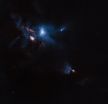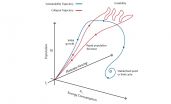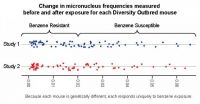Jets, bubbles, and bursts of light in Taurus
2014-11-06
(Press-News.org) The NASA/ESA Hubble Space Telescope has snapped a striking view of a multiple star system called XZ Tauri, its neighbour HL Tauri, and several nearby young stellar objects. XZ Tauri is blowing a hot bubble of gas into the surrounding space, which is filled with bright and beautiful clumps that are emitting strong winds and jets. These objects illuminate the region, creating a truly dramatic scene.
This dark and ominous landscape is located some 450 light-years away in the constellation of Taurus The Bull). It lies in the north-eastern part of a large, dark cloud known as LDN 1551.
Just to the left of centre in this image, embedded within a rust-coloured cloud, lies XZ Tauri. While it appears to be a single star, this bright spot actually consists of several stars. It has long been known to be a binary, but one of these two stars is thought also to be a binary, making a total of three stars within a single system.
This is not the first time that Hubble has observed XZ Tauri -- between the years of 1995 and 2000, a hot bubble of gas was spotted expanding outwards from the system. This bubble can be seen as the small orange lobe very close to the top left of XZ Tauri. This gas is speeding out from the star system, leaving a trail spanning tens of billions of kilometres. As the bubble travels it hits slower moving material, triggering pulses of light and rippling shockwaves.
Above and to the right of XZ Tauri, an equally epic scene is unfolding. Wisps of deep red seem to be streaking away from the blue-tinged clumps on the right. This bright blue patch contains a star known as HL Tauri [1], which is associated with Herbig-Haro object HH 150. Herbig-Haro objects are streaks of hot gas blasted into space by newborn and newly forming stars and LDN 1551 is particularly rich in these dramatic objects.
In the bottom right of this Hubble image is another Herbig-Haro object known as HH 30 (opo9905 - http://www.spacetelescope.org/images/opo9905j/), associated with the variable star V1213 Tauri. The star itself is hidden within a flat, bright disc of dust that is split in half by a dark lane. This dust blocks direct light from V1213 Tauri, but the star is visible via its reflected light and the prominent, knotty jets it is blasting out into space.
Hubble previously viewed HH 30, alongside XZ Tauri, with its Wide Field Planetary Camera 2 between the years of 1995 and 2000. The observations were used to image and study the changes in disc brightness and jet strength over the five-year period. V1213 Tauri's strong magnetic field forms the jets by funnelling and shepherding gas from the disc, accelerating it along the star's magnetic poles to form two narrow beams.
A version of this image was entered into the Hubble's Hidden Treasures image processing competition by contestant Judy Schmidt, and won third prize.
In a press release issued by the European Southern Observatory today observations from the Atacama Large Millimeter/submillimeter Array (ALMA) reveal extraordinarily fine and never-before-seen detail in the planet-forming disc around HL Tauri. The new observations are an enormous step forward in the observation of how protoplanetary discs develop and how planets form.
INFORMATION:
Notes
[1] XZ Tauri and HL Tauri are textbook examples of a class of stars known as T Tauris -- young and rapidly rotating, with strong magnetic fields and powerful winds. They have yet to reach the temperatures necessary for hydrogen fusion deep in their cores. It will take around 100 million years for these stars to trigger these reactions and evolve into fully-fledged stars like the Sun.
Notes for editors
The Hubble Space Telescope is a project of international cooperation between ESA and NASA.
More information
Image credit: ESA/Hubble and NASA
Acknowledgement: Judy Schmidt
Links
* Images of Hubble - http://www.spacetelescope.org/images/archive/category/spacecraft/
* Hubble's Hidden Treasures competition - http://spacetelescope.org/projects/hiddentreasures/
* ESO's press release for the HL Tauri ALMA findings - http://www.eso.org/public/news/eso1436/
* Judy Schmidt's image on Flickr - https://www.flickr.com/photos/geckzilla/6983041144/
Contacts
Georgia Bladon
ESA/Hubble Public Information Officer
Garching, Germany
Tel: +49-89-3200-6855
Email: gbladon@partner.eso.org
[Attachments] See images for this press release:

ELSE PRESS RELEASES FROM THIS DATE:
2014-11-06
Engineers at the University of California, San Diego, are proposing a new surgical intervention for children born with a single ventricle in their heart--instead of the usual two. The new approach would potentially reduce the number of surgeries the patients have to undergo in the first six months of life from two to just one. If successful, it would also create a more stable circuit for blood to flow from the heart to the lungs and the rest of the body within the first days and months of life.
Engineers ran computer simulations of the surgery and found it would reduce ...
2014-11-06
Scientists at Helmholtz Zentrum München (HMGU), at Karolinska Institutet (KI), Stockholm and the University College London investigated the function of ciliary cell extensions in the pancreas. Stimulation of the insulin-producing beta cells increases the number of insulin receptors on their cilia. The cilia consequently play an important role in the release and signal transduction of insulin, a hormone that reduces sugar levels.
Defective cilia lead to elevated blood sugar levels and lowered insulin release
The lead author of the paper Dr. Jantje Gerdes, formerly ...
2014-11-06
Human-caused climate change, ocean acidification and species extinctions may eventually threaten the collapse of civilization, according to some scientists, while other people argue that for political or economic reasons we should allow industrial development to continue without restrictions.
In a new paper, two astrophysicists argue that these questions may soon be resolvable scientifically, thanks to new data about the Earth and about other planets in our galaxy, and by combining the earth-based science of sustainability with the space-oriented field of astrobiology.
"We ...
2014-11-06
This news release is available in German.
"The technique makes it possible for the first time to remove large organic molecules from associated structures and place them elsewhere in a controlled manner," explains Dr. Ruslan Temirov from Jülich's Peter Grünberg Institute. This brings the scientists one step closer to finding a technology that will enable single molecules to be freely assembled to form complex structures. Research groups around the world are working on a modular system like this for nanotechnology, which is considered imperative for the ...
2014-11-06
New research reports that the rate of hospitalization due to hepatitis A virus (HAV) infection has significantly declined in the U.S. from 2002 to 2011. Findings published in Hepatology, a journal of the American Association for the Study of Liver Diseases, show that older patients and those with chronic liver disease are most likely to be hospitalized for HAV. Vaccination of adults with chronic liver disease may prevent infection with hepatitis A and the need for hospitalization.
The World Health Organization (WHO) estimates that each year 1.4 million individuals worldwide ...
2014-11-06
A genetically diverse mouse model is able to predict the range of response to chemical exposures that might be observed in human populations, researchers from the National Institutes of Health have found. Like humans, each Diversity Outbred mouse is genetically unique, and the extent of genetic variability among these mice is similar to the genetic variation seen among humans.
Using these mice, researchers from the National Toxicology Program (NTP), an interagency program headquartered at the National Institute of Environmental Health Sciences (NIEHS), were able to identify ...
2014-11-06
WASHINGTON, D.C., November 6, 2014--Short-term certificate programs at community colleges offer limited labor-market returns, on average, in most fields of study, according to new research published today in Educational Evaluation and Policy Analysis (EEPA), a peer-reviewed journal of the American Educational Research Association. The results of the study, which focused on community college programs in Washington State, are in line with recent research in other states (Kentucky, North Carolina, and Virginia) that found only small economic returns from short-term programs. ...
2014-11-06
WASHINGTON, DC (November 6, 2014)--In honor of Veterans Day, the peer-reviewed journal Women's Health Issues (WHI) today released a new Special Collection on women veterans' health, with a focus on mental health. The special collection also highlights recent studies addressing healthcare services, reproductive health and cardiovascular health of women veterans.
"In recent years, we have seen the Veterans Administration working to improve care and health outcomes of women veterans and service members," said Chloe Bird, editor-in-chief of Women's Health Issues. "The studies ...
2014-11-06
Paramedics respond to a 911 call to find an elderly patient who's having difficulty breathing. Anxious and disoriented, the patient has trouble remembering all the medications he's taking, and with his shortness of breath, speaking is difficult. Is he suffering from acute emphysema or heart failure? The symptoms look the same, but initiating the wrong treatment regimen will increase the patient's risk of severe complications.
Researchers from MIT's Research Laboratory of Electronics, working with physicians from Harvard Medical School and the Einstein Medical Center in ...
2014-11-06
CORVALLIS, Ore. – Power outages have never been more costly. Electricity is critical to communication, transportation, commerce and national security systems, and wide-spread or prolonged outages have the potential to threaten public safety and cause millions, even billions, of dollars in damages.
"It doesn't seem that dire until a storm hits, or somebody makes a mistake, and then you are risking a blackout," said Inara Scott, an assistant professor in the College of Business at Oregon State University.
"You have to consider the magnitude of the potential harm ...
LAST 30 PRESS RELEASES:
[Press-News.org] Jets, bubbles, and bursts of light in Taurus





